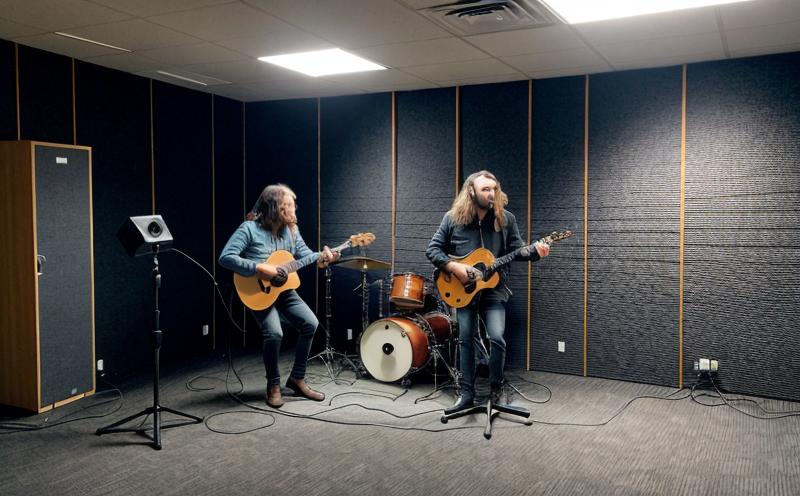ISO 3741 Sound Power Levels in Precision Room Conditions
The ISO 3741 standard provides a comprehensive framework for determining sound power levels of air handling units (AHUs) and other HVAC equipment under precision room conditions. This service ensures that the acoustic performance meets stringent international standards, which is critical for maintaining optimal indoor environments.
Understanding the significance of sound power levels in HVAC equipment testing begins with recognizing how noise pollution affects human health and comfort within buildings. The standard specifies controlled test chambers to eliminate external noise interference, ensuring accurate measurement of intrinsic sound levels generated by the equipment itself. This precision is essential for verifying compliance with regulatory requirements set forth by organizations such as ASHRAE (American Society of Heating, Refrigerating and Air-Conditioning Engineers).
The testing process involves several key steps that guarantee reliability and accuracy. Firstly, the equipment to be tested must undergo thorough preparation in our state-of-the-art laboratories, adhered strictly to ISO 3741 guidelines. This includes isolating the unit from external noise sources through precise placement within the sound test chamber. Secondly, once positioned correctly, the AHU is subjected to specific operating conditions that simulate real-world scenarios like varying airflow rates or temperatures. These controlled environments provide a consistent basis for comparison across different models.
During testing, our expert technicians employ advanced acoustic measurement devices capable of capturing even minute fluctuations in sound pressure levels. The data collected from these instruments forms the foundation upon which we derive precise sound power values using sophisticated software algorithms compliant with ISO 3741 specifications. It's important to note that this process requires meticulous attention to detail throughout every phase, from initial setup through final analysis.
The results generated by our ISO 3741 sound power levels testing are invaluable not only for meeting regulatory standards but also for enhancing overall product quality and performance. By adhering strictly to the stringent parameters outlined in this international standard, manufacturers can ensure their HVAC systems contribute positively towards healthier indoor spaces while minimizing noise pollution outside buildings.
Moreover, compliance with ISO 3741 helps companies build a strong reputation among customers who demand eco-friendly solutions that reduce energy consumption and improve air quality. For R&D teams involved in developing new products or improving existing models, this service offers insights into potential improvements needed to meet current market demands effectively.
For procurement departments looking for reliable suppliers, our ISO 3741 sound power levels testing provides an additional layer of assurance that the chosen equipment meets the highest standards of acoustic performance. This not only enhances customer satisfaction but also fosters trust within industry networks.
Customer Impact and Satisfaction
The implementation of ISO 3741 sound power levels testing brings tangible benefits to customers in various ways:
- Better Indoor Air Quality: By reducing noise emissions from HVAC equipment, this service contributes significantly towards creating more comfortable living spaces. Lower noise levels help reduce stress and improve sleep quality.
- Enhanced Energy Efficiency: Reduced sound power levels often correlate with improved energy efficiency, leading to lower operational costs for customers.
- Regulatory Compliance: Adherence to international standards ensures that products meet regulatory requirements, thereby avoiding potential fines and legal issues.
- Increased Product Lifespan: Proper acoustic testing helps identify design flaws early in the manufacturing process, extending product lifespans and reducing maintenance costs over time.
- Better Reputation: Demonstrating commitment to high-quality products through rigorous testing enhances brand reputation among environmentally conscious consumers.
In summary, ISO 3741 sound power levels testing supports customers by delivering superior HVAC equipment that performs reliably under various conditions while promoting sustainability and customer satisfaction.
International Acceptance and Recognition
The international acceptance of ISO 3741 is widespread across numerous countries, making it a globally recognized standard for sound power level testing in HVAC equipment. Its broad applicability ensures consistent results regardless of geographical location or local regulations.
American Society of Heating, Refrigerating and Air-Conditioning Engineers (ASHRAE) has incorporated ISO 3741 into its guidelines, further emphasizing the standard's importance within the HVAC industry. Similarly, European Norms (EN) have adopted certain aspects of ISO 3741 to ensure harmonization across Europe.
The growing trend towards sustainable practices means that more organizations are adopting ISO 3741 as part of their environmental management systems. By doing so, they demonstrate a proactive approach to reducing noise pollution and promoting healthier indoor environments.
Furthermore, many certification bodies now require adherence to ISO 3741 when issuing certifications related to HVAC equipment. This underscores the standard's role in maintaining high-quality benchmarks across industries.
Environmental and Sustainability Contributions
The focus on sound power levels testing aligns closely with broader environmental goals, particularly those aimed at reducing noise pollution and improving energy efficiency within buildings.
By minimizing noise emissions from HVAC equipment, ISO 3741 contributes to quieter communities by reducing the overall ambient noise level. This has positive implications for public health as prolonged exposure to excessive noise can lead to various health issues such as stress, sleep disturbance, hearing damage, and cardiovascular problems.
In addition to enhancing quality of life outside buildings, minimizing noise pollution within them promotes better sleep patterns and concentration levels among occupants. Studies have shown that even small reductions in background noise can significantly improve cognitive function and reduce symptoms associated with stress disorders.
From an energy efficiency perspective, optimizing sound power levels through rigorous testing helps identify areas where improvements could be made to enhance insulation or airflow management within HVAC systems. Such optimizations not only save on operational costs but also contribute positively towards reducing carbon footprints by conserving resources like electricity and water.
The use of ISO 3741 standards in manufacturing processes ensures that products meet strict environmental criteria established by international organizations such as the United Nations Environment Programme (UNEP). This contributes to global efforts aimed at combating climate change while simultaneously promoting sustainable development practices within local communities.





